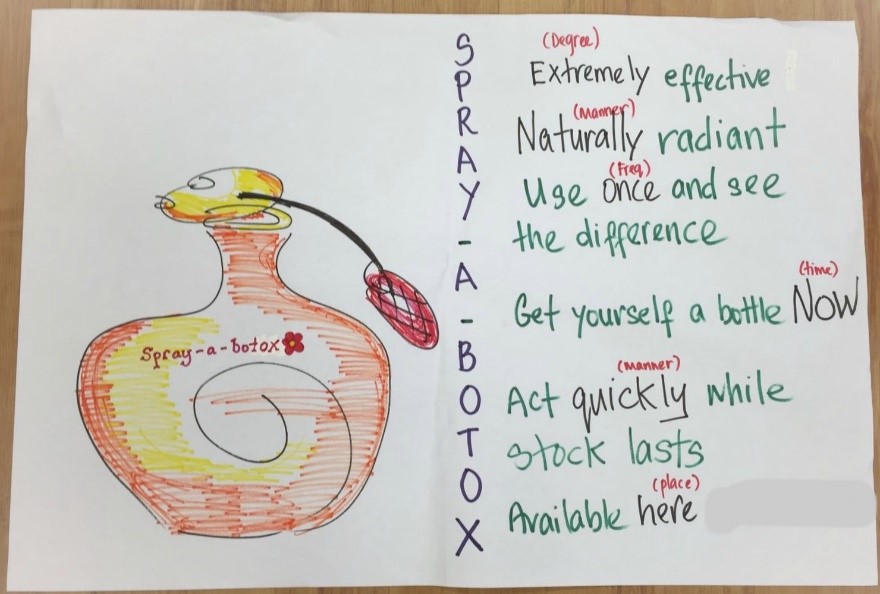Writing Creatively to Learn Adverbs
When it comes to grammar instruction, teachers often struggle with these questions: Do I teach my students the grammar rules explicitly and give them worksheets to practice with? Or do I provide them with different types of texts and examples and allow them to discover the patterns on their own?
Grammar can be taught in a variety of ways: using the inductive and deductive approaches. With the inductive approach, a teacher provides students with carefully selected examples from which a grammatical rule can be inferred. Student learning takes place via self-discovery. If a teacher opts for the deductive approach, she begins the lesson with the sharing of a rule, followed by some exemplifications. Teaching and learning is pretty much rule-driven.
Many have dismissed the rule-driven deductive approach to grammar instruction citing forgettable lessons as a reason; self-discovery is said to be more memorable than teacher explanation. Others have claimed that the deductive approach often involves didactic teaching, which is teacher-fronted, resulting in little teacher-student interaction and low student engagement. Besides, many claim that using metalanguage to explain the rules can be off-putting.
However, there are merits to the deductive approach:
With explicit teaching of grammatical features, the teacher is able to deal with them directly instead of expecting it to come up incidentally in class.
Metalanguage is useful to talk about language and it need not be ‘dull and boring’. It really depends on the teacher’s style and lesson delivery.
Time management: Curriculum time is limited.
Via deductive teaching, the teacher could get straight to the point and the discussion on a grammatical item can be completed in a time-efficient manner.
It is not true that the deductive approach has to be didactic; it can be interactive too!
In my interactions with teachers, I have discovered that many view grammar teaching as standalone lessons involving teaching a grammar rule, followed by plenty of drill and practice exercises. Many do not link grammar teaching to meaningful writing activities; grammar as “meaning-making”. To create awareness and reinforce the importance of linking grammar lessons to writing, I use an activity where a deductive lesson on adverbs is linked to creative writing. Teachers are able to determine how well their students have understood the lesson on adverbs and at the same time, assess their students’ writing skills.
Lesson Plan
Lesson Objective: Students to become aware that there are different types of adverbs which can be used in their writing to add additional information and bring their ideas to life.
Step 1: Explaining adverbs:
what they are, what they do, and where to find them in sentences.
Adverbs are words that describe the circumstances in which an event took place. Adverbs of English typically end with the –ly suffix, but be cautious of many –ly words that are adjectives like friendly, sickly and early.
Adverbs can give us more information about the verb by telling us the time, place and manner of an action or process:
adverbs of time like now, soon, and yesterday.
adverbs of place like here, somewhere, and outside.
adverbs of manner like quickly, nimbly, and quietly.
also includes adverbs of frequency (e.g. often, daily) and adverbs of duration (e.g. briefly, forever).
Adverbs can also add meaning to adjectives, like very happy, so silly and ridiculously strong.
They can also describe other adverbs like He moved so swiftly.
Adverbs also function to connect clauses and sentences together:
First cook the onions, then add the mushrooms. Finally, sprinkle some salt and pepper.
Highlight the variable positions of adverbs in a sentence:
Sentence-initial position: Stealthily, he tiptoed into the room.
Before the verb it describes: He stealthily tiptoed into the room.
Immediately after the verb it describes: He tiptoed stealthily into the room.
Sentence-final position: He tiptoed into the room stealthily.
Step 2: Group activity
Get the students to apply their knowledge of the different types of adverbs, and the different positions adverbs can take (sentence-initial position, at the end of sentences, before or after a verb, and before adjectives). Then get them to work in groups on a writing activity, which allows them to showcase both their knowledge of adverbs and their creative writing.
Write a product caption for this magic potion.

Include 5 adverbs in your caption
As a group, think of a creative use for this purple magic potion. Make your text as interesting as possible. Remember that the caption needs to entice the reader to buy your product. Think of it as an advertisement.
Include 5 adverbs in your caption. Underline the adverbs your group has used (and optionally identify the type of adverb you have included in your caption).
This activity appeals to young learners who enjoy working in groups. Collaborative learning allows them to sound out their ideas to their peers without feeling threatened or embarrassed about ‘getting things wrong’ during the creative process. I also find that students find pride in the text they produce. Teachers will be able to determine how well their students have understood the lesson on adverbs and at the same time, assess their students’ writing skills.
Here are 2 examples of the text produced at the end of this activity:
Example 1:
Spray-a-Botox

Example 2:
Dream potion

I hope teachers will try out this activity the next time they teach adverbs.




